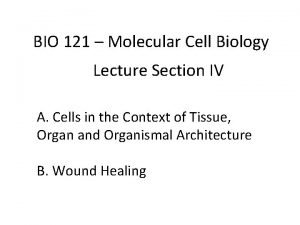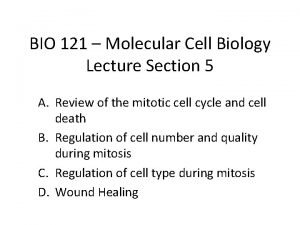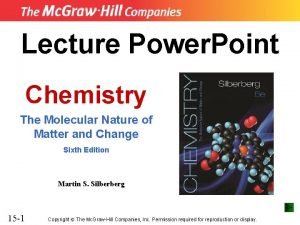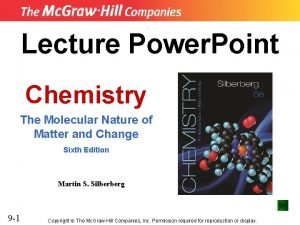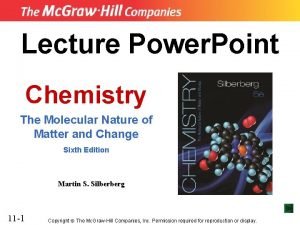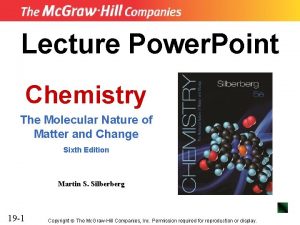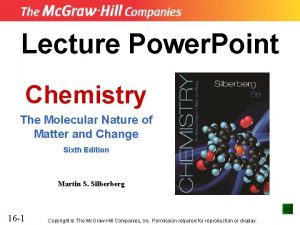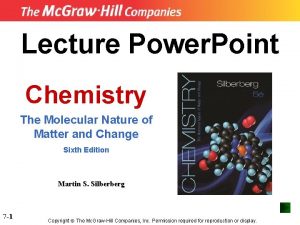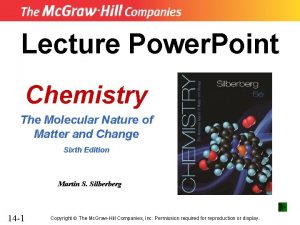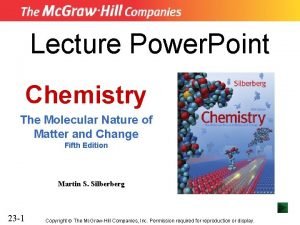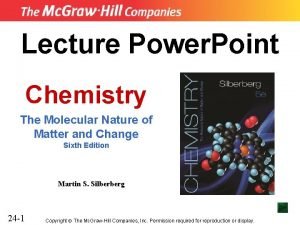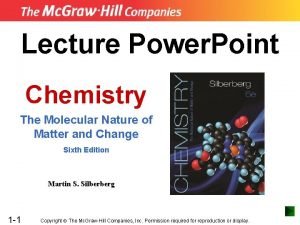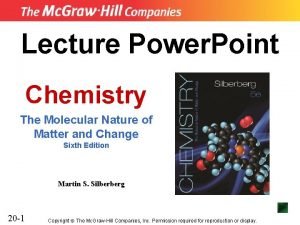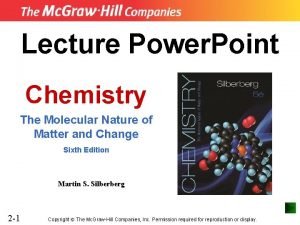Lecture Power Point Chemistry The Molecular Nature of












![Figure 18. 4 The relationship between [H 3 O+] and [OH-] and the relative Figure 18. 4 The relationship between [H 3 O+] and [OH-] and the relative](https://slidetodoc.com/presentation_image_h/d9509c2c0b5bed8d07917f113428ca6e/image-13.jpg)
![Sample Problem 18. 2 PROBLEM: PLAN: Calculating [H 3 O+] and [OH-] in an Sample Problem 18. 2 PROBLEM: PLAN: Calculating [H 3 O+] and [OH-] in an](https://slidetodoc.com/presentation_image_h/d9509c2c0b5bed8d07917f113428ca6e/image-14.jpg)


![Figure 18. 6 18 -17 The relations among [H 3 O+], p. H, [OH-], Figure 18. 6 18 -17 The relations among [H 3 O+], p. H, [OH-],](https://slidetodoc.com/presentation_image_h/d9509c2c0b5bed8d07917f113428ca6e/image-17.jpg)
![Sample Problem 18. 3 PROBLEM: PLAN: Calculating [H 3 O+], p. H, [OH-], and Sample Problem 18. 3 PROBLEM: PLAN: Calculating [H 3 O+], p. H, [OH-], and](https://slidetodoc.com/presentation_image_h/d9509c2c0b5bed8d07917f113428ca6e/image-18.jpg)










![Sample Problem 18. 8 PROBLEM: PLAN: Determining Concentrations from Ka and Initial [HA] Propanoic Sample Problem 18. 8 PROBLEM: PLAN: Determining Concentrations from Ka and Initial [HA] Propanoic](https://slidetodoc.com/presentation_image_h/d9509c2c0b5bed8d07917f113428ca6e/image-29.jpg)
![Sample Problem 18. 8 1. 3 x 10 -5 = [H 3 O+][Pr-] [HPr] Sample Problem 18. 8 1. 3 x 10 -5 = [H 3 O+][Pr-] [HPr]](https://slidetodoc.com/presentation_image_h/d9509c2c0b5bed8d07917f113428ca6e/image-30.jpg)
![[HA]dissociated Percent HA dissociation = x 100 [HA]initial Polyprotic acids with more than one [HA]dissociated Percent HA dissociation = x 100 [HA]initial Polyprotic acids with more than one](https://slidetodoc.com/presentation_image_h/d9509c2c0b5bed8d07917f113428ca6e/image-31.jpg)




![[B] BASE STRENGTH Kb = [BH+][OH-] 18 -36 [B] BASE STRENGTH Kb = [BH+][OH-] 18 -36](https://slidetodoc.com/presentation_image_h/d9509c2c0b5bed8d07917f113428ca6e/image-36.jpg)

![Sample Problem 18. 11 PROBLEM: PLAN: Determining p. H from Kb and Initial [B] Sample Problem 18. 11 PROBLEM: PLAN: Determining p. H from Kb and Initial [B]](https://slidetodoc.com/presentation_image_h/d9509c2c0b5bed8d07917f113428ca6e/image-38.jpg)













- Slides: 51

Lecture Power. Point Chemistry The Molecular Nature of Matter and Change Fifth Edition Martin S. Silberberg 18 -1 Copyright The Mc. Graw-Hill Companies, Inc. Permission required for reproduction or display.

Chapter 18 Acid-Base Equilibria 18 -2

Acid-Base Equilibria 18. 1 Acids and Bases in Water 18. 2 Autoionization of Water and the p. H Scale 18. 3 Proton Transfer and the Brønsted-Lowry Acid-Base Definition 18. 4 Solving Problems Involving Weak-Acid Equilibria 18. 5 Weak Bases and Their Relation to Weak Acids 18. 6 Molecular Properties and Acid Strength 18. 7 Acid-Base Properties of Salt Solutions 18. 8 Generalizing the Brønsted-Lowry Concept: The Leveling Effect 18. 9 Electron-Pair Donation and the Lewis Acid-Base Definition 18 -3

18 -4

Figure 18. 1 The extent of dissociation for strong acids. Strong acid: HA(g or l) + H 2 O(l) 18 -5 H 3 O+(aq) + A-(aq)

Figure 18. 2 The extent of dissociation for weak acids. Weak acid: HA(aq) + H 2 O(l) 18 -6 H 3 O+(aq) + A-(aq)

Figure 18. 3 1 M HCl(aq) 18 -7 Reaction of zinc with a strong and a weak acid. 1 M CH 3 COOH(aq)

Strong acids dissociate completely into ions in water. HA(g or l) + H 2 O(l) H 3 O+(aq) + A-(aq) Kc >> 1 Weak acids dissociate very slightly into ions in water. HA(aq) + H 2 O(l) H 3 O+(aq) + A-(aq) Kc << 1 The Acid-Dissociation Constant [H 3 O+][A-] Kc = [H 2 O][HA] Kc[H 2 O] = Ka = stronger acid higher [H 3 O+] larger Ka [H 3 O+][A-] [HA] smaller Ka lower [H 3 O+] weaker acid 18 -8

18 -9 ACID STRENGTH

Sample Problem 18. 1 PROBLEM: Classify each of the following compounds as a strong acid, weak acid, strong base, or weak base. (a) H 2 Se. O 4 PLAN: Classifying Acid and Base Strength from the Chemical Formula (b) (CH 3)2 CHCOOH (c) KOH (d) (CH 3)2 CHNH 2 Pay attention to the text definitions of acids and bases. Look at O for acids as well as the -COOH group; watch for amine groups and cations in bases. SOLUTION: (a) Strong acid - H 2 Se. O 4 - the number of O atoms exceeds the number of ionizable protons by 2. (b) Weak acid - (CH 3)2 CHCOOH is an organic acid having a -COOH group. (c) Strong base - KOH is a Group 1 A(1) hydroxide. (d) Weak base - (CH 3)2 CHNH 2 has a lone pair of electrons on the N and is an amine. 18 -10

Autoionization of Water and the p. H Scale + H 2 O(l) + H 3 O+(aq) 18 -11 OH-(aq)

H 2 O(l) + H 2 O(l) Kc = H 3 O+(aq) + OH-(aq) [H 3 O+][OH-] [H 2 O]2 The Ion-Product Constant for Water Kc[H 2 O]2 = Kw = [H 3 O+][OH-] = 1. 0 x 10 -14 at 25 o. C A change in [H 3 O+] causes an inverse change in [OH-]. In an acidic solution, [H 3 O+] > [OH-] In a basic solution, [H 3 O+] < [OH-] In a neutral solution, [H 3 O+] = [OH-] 18 -12
![Figure 18 4 The relationship between H 3 O and OH and the relative Figure 18. 4 The relationship between [H 3 O+] and [OH-] and the relative](https://slidetodoc.com/presentation_image_h/d9509c2c0b5bed8d07917f113428ca6e/image-13.jpg)
Figure 18. 4 The relationship between [H 3 O+] and [OH-] and the relative acidity of solutions. [H 3 O+] Divide into Kw [OH-] [H 3 O+] > [OH-] [H 3 O+] = [OH-] [H 3 O+] < [OH-] ACIDIC SOLUTION 18 -13 NEUTRAL SOLUTION BASIC SOLUTION
![Sample Problem 18 2 PROBLEM PLAN Calculating H 3 O and OH in an Sample Problem 18. 2 PROBLEM: PLAN: Calculating [H 3 O+] and [OH-] in an](https://slidetodoc.com/presentation_image_h/d9509c2c0b5bed8d07917f113428ca6e/image-14.jpg)
Sample Problem 18. 2 PROBLEM: PLAN: Calculating [H 3 O+] and [OH-] in an Aqueous Solution A research chemist adds a measured amount of HCl gas to pure water at 25 o. C and obtains a solution with [H 3 O+] = 3. 0 x 10 -4 M. Calculate [OH-]. Is the solution neutral, acidic, or basic? Use the Kw at 25 o. C and the [H 3 O+] to find the corresponding [OH-]. SOLUTION: K = 1. 0 x 10 -14 = [H O+] [OH-] so w 3 [OH-] = Kw/ [H 3 O+] = 1. 0 x 10 -14/3. 0 x 10 -4 = 3. 3 x 10 -11 M [H 3 O+] is > [OH-] and the solution is acidic. 18 -14

Figure 18. 5 The p. H values of some familiar aqueous solutions. p. H = -log [H 3 O+] 18 -15

Table 18. 3 The Relationship Between Ka and p. Ka Acid Name (Formula) Ka at 25 o. C p. Ka Hydrogen sulfate ion (HSO 4 -) 1. 0 x 10 -2 1. 99 Nitrous acid (HNO 2) 7. 1 x 10 -4 3. 15 Acetic acid (CH 3 COOH) 1. 8 x 10 -5 4. 74 Hypobromous acid (HBr. O) 2. 3 x 10 -9 8. 64 1. 0 x 10 -10 10. 00 Phenol (C 6 H 5 OH) 18 -16
![Figure 18 6 18 17 The relations among H 3 O p H OH Figure 18. 6 18 -17 The relations among [H 3 O+], p. H, [OH-],](https://slidetodoc.com/presentation_image_h/d9509c2c0b5bed8d07917f113428ca6e/image-17.jpg)
Figure 18. 6 18 -17 The relations among [H 3 O+], p. H, [OH-], and p. OH.
![Sample Problem 18 3 PROBLEM PLAN Calculating H 3 O p H OH and Sample Problem 18. 3 PROBLEM: PLAN: Calculating [H 3 O+], p. H, [OH-], and](https://slidetodoc.com/presentation_image_h/d9509c2c0b5bed8d07917f113428ca6e/image-18.jpg)
Sample Problem 18. 3 PROBLEM: PLAN: Calculating [H 3 O+], p. H, [OH-], and p. OH In an art restoration project, a conservator prepares copperplate etching solutions by diluting concentrated HNO 3 to 2. 0 M, 0. 30 M, and 0. 0063 M HNO 3. Calculate [H 3 O+], p. H, [OH-], and p. OH of the three solutions at 25 o. C. HNO 3 is a strong acid so [H 3 O+] = [HNO 3]. Use Kw to find the [OH-] and then convert to p. H and p. OH. SOLUTION: For 2. 0 M HNO 3, [H 3 O+] = 2. 0 M and -log [H 3 O+] = -0. 30 = p. H [OH-] = Kw/ [H 3 O+] = 1. 0 x 10 -14/2. 0 = 5. 0 x 10 -15 M; p. OH = 14. 30 For 0. 3 M HNO 3, [H 3 O+] = 0. 30 M and -log [H 3 O+] = 0. 52 = p. H [OH-] = Kw/ [H 3 O+] = 1. 0 x 10 -14/0. 30 = 3. 3 x 10 -14 M; p. OH = 13. 48 For 0. 0063 M HNO 3, [H 3 O+] = 0. 0063 M and -log [H 3 O+] = 2. 20 = p. H [OH-] = Kw/ [H 3 O+] = 1. 0 x 10 -14/6. 3 x 10 -3 = 1. 6 x 10 -12 M; p. OH = 11. 80 18 -18

Figure 18. 7 Methods for measuring the p. H of an aqueous solution. p. H (indicator) paper p. H meter 18 -19

Figure 18. 8 Proton transfer as the essential feature of a Brønsted. Lowry acid-base reaction. Lone pair binds H+ (acid, H+ donor) (base, H+ acceptor) Lone pair binds H+ (base, H+ acceptor) 18 -20 (acid, H+ donor)

Brønsted-Lowry Acid-Base Definition An acid is a proton donor, any species which donates a H+. A base is a proton acceptor, any species which accepts a H+. An acid-base reaction can now be viewed from the standpoint of the reactants AND the products. An acid reactant will produce a base product and the two will constitute an acid-base conjugate pair. 18 -21

Table 18. 4 The Conjugate Pairs in Some Acid-Base Reactions Conjugate Pair Acid + Base + Acid Conjugate Pair Reaction 1 HF + H 2 O F- + H 3 O + Reaction 2 HCOOH + CN- HCOO- + HCN Reaction 3 NH 4+ + CO 32 - NH 3 + HCO 3 - Reaction 4 H 2 PO 4 - + OH- HPO 42 - + H 2 O Reaction 5 H 2 SO 4 + N 2 H 5 + HSO 4 - + N 2 H 62+ Reaction 6 HPO 42 - + SO 32 - PO 43 - + HSO 3 - 18 -22

Sample Problem 18. 4 PROBLEM: Identifying Conjugate Acid-Base Pairs The following reactions are important environmental processes. Identify the conjugate acid-base pairs. (a) H 2 PO 4 -(aq) + CO 32 -(aq) (b) H 2 O(l) + SO 32 -(aq) PLAN: HPO 42 -(aq) + HCO 3 -(aq) OH-(aq) + HSO 3 -(aq) Identify proton donors (acids) and proton acceptors (bases). conjugate pair 2 conjugate pair 1 SOLUTION: (a) H 2 PO 4 -(aq) + CO 32 -(aq) proton donor proton acceptor HPO 42 -(aq) + HCO 3 -(aq) proton acceptor conjugate pair 2 conjugate pair 1 (b) H 2 O(l) + SO 32 -(aq) proton donor acceptor 18 -23 proton donor OH-(aq) + HSO 3 -(aq) proton acceptor proton donor

Sample Problem 18. 5 PROBLEM: Predicting the Net Direction of an Acid-Base Reaction Predict the net direction and whether Kc is greater or less than 1 for each of the following reactions (assume equal initial concentrations of all species): (a) H 2 PO 4 -(aq) + NH 3(aq) (b) H 2 O(l) + HS-(aq) PLAN: HPO 42 -(aq) + NH 4+(aq) OH-(aq) + H 2 S(aq) Identify the conjugate acid-base pairs and then consult Figure 18. 9 (button) to determine the relative strength of each. The stronger the species, the more preponderant its conjugate. SOLUTION: (a) H 2 PO 4 -(aq) + NH 3(aq) stronger acid stronger base HPO 42 -(aq) + NH 4+(aq) weaker base weaker acid Net direction is to the right with Kc > 1. (b) H 2 O(l) + HS-(aq) 18 -24 OH-(aq) + H 2 S(aq) weaker acid weaker base stronger acid Net direction is to the left with Kc < 1.

Figure 18. 9 Strengths of conjugate acidbase pairs. 18 -25

Sample Problem 18. 6 PROBLEM: PLAN: A 0. 10 M solution of HX (blue and green) has a p. H of 2. 88 and a 0. 10 M solution of HY (blue and orange) has a p. H 3. 52, which scene best represents the equilibrium mixture after equimolar solutions of HX and Y- (orange) are mixed? Determine the relative acid strengths of HX and HY. The p. H values are given at the same concentration of weak acid solutions, so pick the stronger acid directly from these values. The stronger acid will have fewer molecules of it in molecular scene than the weaker acid. SOLUTION: 18 -26 Using Molecular Scenes to Predict the Net Direction of an Acid-Base Reaction The HX solution has a lower p. H than the HY solution and is the stronger acid. Y- is the stronger base. Therefore, the reaction of HX and Y- has a Kc > 1 and the mixture will have more HY than HX. Scene 3 is consistent with the relative acid strengths.

Sample Problem 18. 7 PROBLEM: PLAN: Finding the Ka of a Weak Acid from the Solution p. H Phenylacetic acid (C 6 H 5 CH 2 COOH, simplified here as HPAc) builds up in the blood of persons with phenylketonuria, an inherited disorder that, if untreated, causes mental retardation and death. A study of the acid shows that the p. H of 0. 12 M HPAc is 2. 62. What is the Ka of phenylacetic acid? Write out the dissociation equation. Use p. H and solution concentration to find the Ka. Assumptions: SOLUTION: With a p. H of 2. 62, the [H 3 O+]HPAc >> [H 3 O+]water. [PAc-] ≈ [H 3 O+]; since HPAc is weak, [HPAc]initial ≈ [HPAc]initial [HPAc]dissociation HPAc(aq) + H 2 O(l) Ka = [H 3 O+][PAc-] [HPAc] 18 -27 H 3 O+(aq) + PAc-(aq)

Sample Problem 18. 7 Concentration (M) Initial Change Equilibrium Finding the Ka of a Weak Acid from the Solution p. H HPAc(aq) + H 2 O(l) H 3 O+(aq) + PAc-(aq) 0. 12 - 0 0 -x - +x +x 0. 12 - x x [H 3 O+] = 10 -p. H = 2. 4 x 10 -3 M which is >> 10 -7 (the [H 3 O+] from water) x ≈ 2. 4 x 10 -3 M ≈ [H 3 O+] ≈ [PAc-] So Ka = (2. 4 x 10 -3) 0. 12 [HPAc]equilibrium = 0. 12 - x ≈ 0. 12 M = 4. 8 x 10 -5 Be sure to check for % error. [H 3 O+ ] from water; [HPAc]dissn; 18 -28 1 x 10 -7 M x 100 = 4 x 10 -3 % 2. 4 x 10 -3 M x 100 = 2. 0 % 0. 12 M
![Sample Problem 18 8 PROBLEM PLAN Determining Concentrations from Ka and Initial HA Propanoic Sample Problem 18. 8 PROBLEM: PLAN: Determining Concentrations from Ka and Initial [HA] Propanoic](https://slidetodoc.com/presentation_image_h/d9509c2c0b5bed8d07917f113428ca6e/image-29.jpg)
Sample Problem 18. 8 PROBLEM: PLAN: Determining Concentrations from Ka and Initial [HA] Propanoic acid (CH 3 CH 2 COOH, which we simplify as HPr) is an organic acid whose salts are used to retard mold growth in foods. What is the [H 3 O+] of 0. 10 M HPr (Ka = 1. 3 x 10− 5)? Write out the dissociation equation and expression; make whatever assumptions about concentration which are necessary; substitute. Assumptions: For HPr(aq) + H 2 O(l) H 3 O+(aq) + Pr−(aq) x = [HPr]diss = [H 3 O+]from HPr= [Pr−] Ka = [H 3 O+][Pr−] [HPr] SOLUTION: Concentration (M) Initial Change Equilibrium HPr(aq) + H 2 O(l) H 3 O+(aq) + Pr-(aq) 0. 10 - 0 0 −x - +x +x 0. 10 - x x Since Ka is small, we will assume that x << 0. 10 18 -29
![Sample Problem 18 8 1 3 x 10 5 H 3 OPr HPr Sample Problem 18. 8 1. 3 x 10 -5 = [H 3 O+][Pr-] [HPr]](https://slidetodoc.com/presentation_image_h/d9509c2c0b5bed8d07917f113428ca6e/image-30.jpg)
Sample Problem 18. 8 1. 3 x 10 -5 = [H 3 O+][Pr-] [HPr] Determining Concentrations from Ka and Initial [HA] = (x)(x) 0. 10 = 1. 1 x 10 -3 M = [H 3 O+] Check: [HPr]diss = 1. 1 x 10 -3 M/0. 10 M x 100 = 1. 1% 18 -30
![HAdissociated Percent HA dissociation x 100 HAinitial Polyprotic acids with more than one [HA]dissociated Percent HA dissociation = x 100 [HA]initial Polyprotic acids with more than one](https://slidetodoc.com/presentation_image_h/d9509c2c0b5bed8d07917f113428ca6e/image-31.jpg)
[HA]dissociated Percent HA dissociation = x 100 [HA]initial Polyprotic acids with more than one ionizable proton H 3 PO 4(aq) + H 2 O(l) H 2 PO 4 -(aq) + H 3 O+(aq) Ka 1 = [H 3 O+][H 2 PO 4 -] [H 3 PO 4] = 7. 2 x 10 -3 H 2 PO 4 -(aq) + H 2 O(l) HPO 4 2 -(aq) + H 3 O+(aq) Ka 2 = [H 3 O+][HPO 42 -] [H 2 PO 4 -] = 6. 3 x 10 -8 HPO 4 2 -(aq) + H 2 O(l) PO 4 3 -(aq) + H 3 O+(aq) Ka 1 > Ka 2 > Ka 3 18 -31 Ka 3 = [H 3 O+][PO 43 -] [HPO 42 -] = 4. 2 x 10 -13

Sample Problem 18. 9 PROBLEM: PLAN: Using Molecular Scenes to Determine the Extent of HA Dissociation A 0. 15 M solution of acid HA (blue and green) is 33% dissociated. Which scene best represents a sample of the solution after it is diluted with water? Percent dissociation increase as solution is diluted. Calculate the percent dissociation of each sample. [H 3 O+] % dissociation = x 100% [HA] + [H 3 O+] SOLUTION: Solution 1. % dissociated = 4/(5 + 4) x 100 = 44% Solution 2. % dissociated = 2/(7 + 2) x 100 = 22% Solution 3. % dissociated = 3/(6 + 3) x 100 = 33% Scene 1 represents the diluted solution. 18 -32

18 -33 ACID STRENGTH

Sample Problem 18. 10 PROBLEM: PLAN: Calculating Equilibrium Concentrations for a Polyprotic Acid Ascorbic acid (H 2 C 6 H 6 O 6; H 2 Asc for this problem), known as vitamin C, is a diprotic acid (Ka 1 = 1. 0 x 10 -5 and Ka 2 = 5 x 10 -12) found in citrus fruit. Calculate [H 2 Asc], [HAsc-], [Asc 2 -], and the p. H of 0. 050 M H 2 Asc. Write out expressions for both dissociations and make assumptions. Ka 1 >> Ka 2 so the first dissociation produces virtually all of the H 3 O+. Ka 1 is small so [H 2 Asc]initial ≈ [H 2 Asc] After finding the concentrations of various species for the first dissociation, we can use them as initial concentrations for the second dissociation. SOLUTION: H 2 Asc(aq) + H 2 O(l) HAsc-(aq) 18 -34 + H 2 O(l) HAsc-(aq) + H 3 O+(aq) Asc 2 -(aq) + H 3 O+(aq) Ka 1 = Ka 2 = [HAsc-][H 3 O+] [H 2 Asc] [Asc 2 -][H 3 O+] [HAsc-] = 1. 0 x 10 -5 = 5 x 10 -12

Sample Problem 18. 10 Concentration (M) Initial Change Equilibrium Calculating Equilibrium Concentrations for a Polyprotic Acid H 2 Asc(aq) + H 2 O(l) HAsc-(aq) + H 3 O+(aq) 0. 050 - 0 0 -x - +x +x 0. 050 - x x Ka 1 = [HAsc-][H 3 O+]/[H 2 Asc] = 1. 0 x 10 -5 = (x)(x)/0. 050 M x = 7. 1 x 10 -4 M x Concentration (M) Initial Change Equilibrium HAsc-(aq) + H 2 O(l) 7. 1 x 10 -4 M -x 7. 1 x 10 -4 - x p. H = -log(7. 1 x 10 -4) = 3. 15 Asc 2 -(aq) + H 3 O+(aq) - 0 7. 1 x 10 -4 M - +x +x - x 7. 1 x 10 -4 - x Ka 2 = [Asc 2 -][H 3 O+]/[HAsc-] = 5 x 10 -12 = (x)(7. 1 x 10 -4 - x)/ (7. 1 x 10 -4 - x) M = x 18 -35
![B BASE STRENGTH Kb BHOH 18 36 [B] BASE STRENGTH Kb = [BH+][OH-] 18 -36](https://slidetodoc.com/presentation_image_h/d9509c2c0b5bed8d07917f113428ca6e/image-36.jpg)
[B] BASE STRENGTH Kb = [BH+][OH-] 18 -36

Figure 18. 10 Abstraction of a proton from water by methylamine. Lone pair binds H+ + CH 3 NH 2 O methylamine + CH 3 NH 3+ methylammonium ion 18 -37 OH-
![Sample Problem 18 11 PROBLEM PLAN Determining p H from Kb and Initial B Sample Problem 18. 11 PROBLEM: PLAN: Determining p. H from Kb and Initial [B]](https://slidetodoc.com/presentation_image_h/d9509c2c0b5bed8d07917f113428ca6e/image-38.jpg)
Sample Problem 18. 11 PROBLEM: PLAN: Determining p. H from Kb and Initial [B] Dimethylamine, (CH 3)2 NH, a key intermediate in detergent manufacture, has a Kb of 5. 9 x 10 -4. What is the p. H of 1. 5 M (CH 3)2 NH? Perform this calculation as you did those for acids. Keep in mind that you are working with Kb and a base. (CH 3)2 NH(aq) + H 2 O(l) (CH 3)2 NH 2+(aq) + OH-(aq) Assumptions: Kb >> Kw so [OH-]from water is negligible [(CH 3)2 NH 2+] = [OH-] = x ; [(CH 3)2 NH 2+] - x ≈ [(CH 3)2 NH]initial SOLUTION: Concentration Initial Change Equilibrium 18 -38 (CH 3)2 NH(aq) + H 2 O(l) (CH 3)2 NH 2+(aq) + OH-(aq) 1. 50 M - 0 0 -x - +x +x 1. 50 - x x

Sample Problem 18. 11 Kb = 5. 9 x 10 -4 = Determining p. H from Kb and Initial [B] [(CH 3)2 NH 2+][OH-] (x)(x) 1. 5 M Check assumption: [(CH 3)2 NH] x = 3. 0 x 10 -2 M = [OH-] 3. 0 x 10 -2 M/1. 5 M x 100 = 2% [H 3 O+] = Kw/[OH-] = 1. 0 x 10 -14/3. 0 x 10 -2 = 3. 3 x 10 -13 M p. H = -log 3. 3 x 10 -13 = 12. 48 18 -39

Sample Problem 18. 12 PROBLEM: PLAN: Determining the p. H of a Solution of A- Sodium acetate (CH 3 COONa, or Na. Ac for this problem) has applications in photographic development and textile dyeing. What is the p. H of 0. 25 M Na. Ac? Ka of acetic acid (HAc) is 1. 8 x 10 -5. Sodium salts are soluble in water so [Ac-] = 0. 25 M. Write the association equation for acetic acid; use the Ka to find the Kb. SOLUTION: Concentration Ac-(aq) + H 2 O(l) Initial Change Equilibrium Kb = 18 -40 [HAc][OH-] [Ac-] 0. 25 M - 0 0 -x - +x +x - x x 0. 25 M - x = HAc(aq) + OH-(aq) Kw Ka Kb = 1. 0 x 10 -14 1. 8 x 10 -5 = 5. 6 x 10 -10 M

Sample Problem 18. 12 Kb = Determining the p. H of a Solution of A- [Ac-] = 0. 25 M - x ≈ 0. 25 M [HAc][OH-] [Ac-] 5. 6 x 10 -10 = x 2/0. 25 M x = 1. 2 x 10 -5 M = [OH-] Check assumption: 1. 2 x 10 -5 M/0. 25 M x 100 = 4. 8 x 10 -3 % [H 3 O+] = Kw/[OH-] = 1. 0 x 10 -14/1. 2 x 10 -5 = 8. 3 x 10 -10 M p. H = -log 8. 3 x 10 -10 M = 9. 08 18 -41

Bond strength decreases, acidity increases Figure 18. 11 18 -42 The effect of atomic and molecular properties on nonmetal hydride acidity. 6 A(16) 7 A(17) H 2 O HF H 2 S HCl H 2 Se HBr H 2 Te HI Electronegativity increases, acidity increases

Figure 18. 12 H O The relative strengths of oxoacids. I < H O < Br H O O H O Cl << H O Cl O 18 -43 O Cl

Table 18. 7 Ka Values of Some Hydrated Metal Ions at 25 o. C 18 -44 Hydrated Ion Ka Fe 3+ Fe(H 2 O)63+(aq) 6 x 10 -3 Sn 2+ Sn(H 2 O)62+(aq) 4 x 10 -4 Cr 3+ Cr(H 2 O)63+(aq) 1 x 10 -4 Al 3+ Al(H 2 O)63+(aq) 1 x 10 -5 Cu 2+ Cu(H 2 O)62+(aq) 3 x 10 -8 Pb 2+ Pb(H 2 O)62+(aq) 3 x 10 -8 Zn 2+ Zn(H 2 O)62+(aq) 1 x 10 -9 Co 2+ Co(H 2 O)62+(aq) 2 x 10 -10 Ni 2+ Ni(H 2 O)62+(aq) 1 x 10 -10 ACID STRENGTH Free Ion

Figure 18. 13 The acidic behavior of the hydrated Al 3+ ion. Electron density drawn toward Al 3+ Nearby H 2 O acts as base H 2 O Al(H 2 O)63+ 18 -45 H 3 O + Al(H 2 O)5 OH 2+

Sample Problem 18. 13 PROBLEM: PLAN: Predicting Relative Acidity of Salt Solutions Predict whether aqueous solutions of the following are acidic, basic, or neutral, and write an equation for the reaction of any ion with water: (a) Potassium perchlorate, KCl. O 4 (b) Sodium benzoate, C 6 H 5 COONa (c) Chromium (III) nitrate, Cr(NO 3)3 Consider the acid-base nature of the anions and cations. Strong acid-strong base combinations produce a neutral solution; strong acid-weak base, acidic; weak acid-strong base, basic. SOLUTION: (a) The ions are K+ and Cl. O 4 - , both of which come from a strong base (KOH) and a strong acid (HCl. O 4). Therefore the solution will be neutral. (b) Na+ comes from the strong base Na. OH while C 6 H 5 COO- is the anion of a weak organic acid. The salt solution will be basic. C 6 H 5 OO-(aq) + H 2 O(l) C 6 H 5 OOH(aq) + OH-(aq) (c) Cr 3+ is a small cation with a large + charge, so it’s hydrated form will react with water to produce H 3 O+. Cl- comes from the strong acid HCl. Acidic solution. Cr(H 2 O)63+(aq) + H 2 O(l) 18 -46 Cr(H 2 O)5 OH 2+(aq) + H 3 O+(aq)

18 -47

Sample Problem 18. 14 PROBLEM: PLAN: Predicting the Relative Acidity of Salt Solutions from Ka and Kb of the Ions Determine whether an aqueous solution of zinc formate, Zn(HCOO)2, is acidic, basic, or neutral. Both Zn 2+ and HCOO- come from weak conjugates. In order to find the relative acidity, write out the dissociation reactions and use the information in Tables 18. 2 and 18. 7. SOLUTION: Zn(H 2 O)62+(aq) + H 2 O(l) HCOO-(aq) + H 2 O(l) Zn(H 2 O)5 OH+(aq) + H 3 O+(aq) HCOOH(aq) + OH-(aq) Ka Zn(H 2 O)62+ = 1 x 10 -9 Ka HCOO- = 1. 8 x 10 -4 ; Kb = Kw/Ka = 1. 0 x 10 -14/1. 8 x 10 -4 = 5. 6 x 10 -11 Ka for Zn(H 2 O)62+ >>> Kb HCOO-, therefore the solution is acidic. 18 -48

Molecules as Lewis Acids An acid is an electron-pair acceptor. A base is an electron-pair donor. acid 18 -49 base adduct

Figure 18. 14 The Mg 2+ ion as a Lewis acid in the chlorophyll molecule. 18 -50

Sample Problem 18. 15 PROBLEM: PLAN: Identifying Lewis Acids and Bases Identify the Lewis acids and Lewis bases in the following reactions: (a) H+ + OH- H 2 O (b) Cl- + BCl 3 BCl 4 - (c) K+ + 6 H 2 O K(H 2 O)6+ Look for electron pair acceptors (acids) and donors (bases). SOLUTION: acceptor (a) H+ + OHdonor (b) Cl- + BCl 3 acceptor (c) K+ + 6 H 2 O donor 18 -51 H 2 O BCl 4 - K(H 2 O)6+
 01:640:244 lecture notes - lecture 15: plat, idah, farad
01:640:244 lecture notes - lecture 15: plat, idah, farad Molecular biology lecture
Molecular biology lecture Enteroendocrine cell
Enteroendocrine cell Cleavage
Cleavage Covalent bond boiling point
Covalent bond boiling point Ionic covalent metallic
Ionic covalent metallic Zinc oxide + nitric acid → zinc nitrate + water
Zinc oxide + nitric acid → zinc nitrate + water Ac power formula
Ac power formula Informsu
Informsu Point point power
Point point power Advanced inorganic chemistry lecture notes
Advanced inorganic chemistry lecture notes Lightning elves
Lightning elves Fifth edition chemistry a molecular approach
Fifth edition chemistry a molecular approach Ap chemistry unit 9 notes
Ap chemistry unit 9 notes Power system dynamics and stability lecture notes
Power system dynamics and stability lecture notes Power system analysis lecture notes
Power system analysis lecture notes Power semiconductor devices lecture notes
Power semiconductor devices lecture notes Switch mode power supply lecture notes
Switch mode power supply lecture notes Power system dynamics and stability lecture notes
Power system dynamics and stability lecture notes Things fall apart customs
Things fall apart customs Nature and nature's law lay hid in night
Nature and nature's law lay hid in night Determinace lidské psychiky
Determinace lidské psychiky Non examples of homogeneous mixture
Non examples of homogeneous mixture Chapter 4 basic food chemistry the nature of matter
Chapter 4 basic food chemistry the nature of matter Chapter 4 basic food chemistry the nature of matter
Chapter 4 basic food chemistry the nature of matter Ib organic chemistry functional groups
Ib organic chemistry functional groups Inorganic chemistry vs organic chemistry
Inorganic chemistry vs organic chemistry Hát kết hợp bộ gõ cơ thể
Hát kết hợp bộ gõ cơ thể Bổ thể
Bổ thể Tỉ lệ cơ thể trẻ em
Tỉ lệ cơ thể trẻ em Gấu đi như thế nào
Gấu đi như thế nào Chụp phim tư thế worms-breton
Chụp phim tư thế worms-breton Chúa yêu trần thế
Chúa yêu trần thế Môn thể thao bắt đầu bằng chữ f
Môn thể thao bắt đầu bằng chữ f Thế nào là hệ số cao nhất
Thế nào là hệ số cao nhất Các châu lục và đại dương trên thế giới
Các châu lục và đại dương trên thế giới Công thức tiính động năng
Công thức tiính động năng Trời xanh đây là của chúng ta thể thơ
Trời xanh đây là của chúng ta thể thơ Mật thư tọa độ 5x5
Mật thư tọa độ 5x5 Phép trừ bù
Phép trừ bù độ dài liên kết
độ dài liên kết Các châu lục và đại dương trên thế giới
Các châu lục và đại dương trên thế giới Thơ thất ngôn tứ tuyệt đường luật
Thơ thất ngôn tứ tuyệt đường luật Quá trình desamine hóa có thể tạo ra
Quá trình desamine hóa có thể tạo ra Một số thể thơ truyền thống
Một số thể thơ truyền thống Cái miệng xinh xinh thế chỉ nói điều hay thôi
Cái miệng xinh xinh thế chỉ nói điều hay thôi Vẽ hình chiếu vuông góc của vật thể sau
Vẽ hình chiếu vuông góc của vật thể sau Thế nào là sự mỏi cơ
Thế nào là sự mỏi cơ đặc điểm cơ thể của người tối cổ
đặc điểm cơ thể của người tối cổ Ví dụ giọng cùng tên
Ví dụ giọng cùng tên Vẽ hình chiếu đứng bằng cạnh của vật thể
Vẽ hình chiếu đứng bằng cạnh của vật thể


